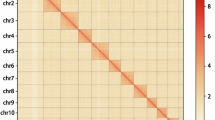Abstract
IN the Phasmoptera bisexual and parthenogenetic reproduction both occur. In several species males have never been found, or appear to be extremely scarce. Some observations under natural conditions and many in captivity have established that the reproduction of these species is parthenogenetic and thelytokous1–6. Well-known examples of this group are Carausius morosus Br. from India, and the south European populations of Bacillus rossii F. and Clonopsis gallica Charp.
This is a preview of subscription content, access via your institution
Access options
Subscribe to this journal
Receive 51 print issues and online access
$199.00 per year
only $3.90 per issue
Buy this article
- Purchase on SpringerLink
- Instant access to full article PDF
Prices may be subject to local taxes which are calculated during checkout
Similar content being viewed by others
References
Chopard, L., Année biol. (Paris), 52, 15 (1948).
Chopard, L., Faune de France, 56 (Lechevalier, Paris, 1951).
Cappe de Baillon, P., Favrelle, M., and de Vichet, G., Bull. Biol. Fr. Belg., 72, 1 (1938).
Beier, M., in Bronn, Klassen und Ordnungen des Tierreichs, Pt. 5, Div. 3, 6, No. 2, 305 (1957).
Bergérard, J., Bull. Biol. Fr. Belg., 92, 87 (1958).
Pijnacker, L., thesis, State University, Groningen (in preparation).
Günther, K., Proc. Seventh Intern. Congr. Ent., Berlin, 2, 1156 (1939).
Kuyten, P., Proc. Roy. Dutch. Acad. Sci., C, 64, 3, 305 (1961).
Author information
Authors and Affiliations
Rights and permissions
About this article
Cite this article
KUYTEN, P. Duration of Life, Egg Number and Parthenogenesis in the Stick Insect Orxines macklotti De Haan. Nature 195, 1124–1125 (1962). https://doi.org/10.1038/1951124a0
Issue date:
DOI: https://doi.org/10.1038/1951124a0



